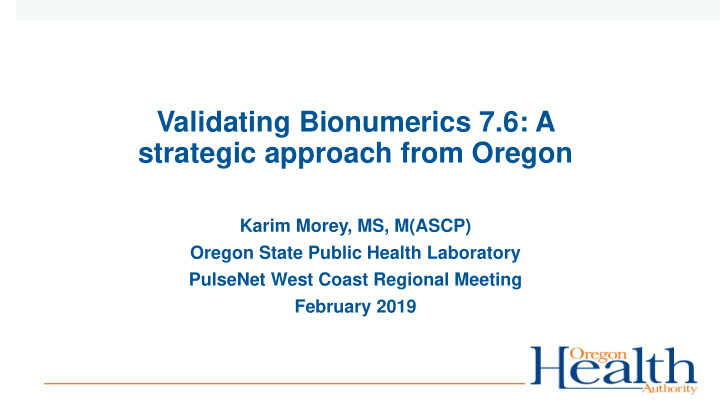



Validating Bionumerics 7.6: A strategic approach from Oregon Karim Morey, MS, M(ASCP) Oregon State Public Health Laboratory PulseNet West Coast Regional Meeting February 2019
Outline • Compliance requirements • Strategy development • Strategy description • Summary and discussion
WGS GS Ana Analysis Validation/Verification • What type of approach should be applied if lab is CLIA certified and CAP accredited? • Guidelines available? • Is it Validation or Verification? • What needs to be verified or validated?
Definitions VALID IDATION “…the process of assessing the assay and its performance characteristics to determine the optimal conditions that will generate a reproducible and accurate result…” VERIFICATI TION One-time process to determine or confirm a test’s expected performance compared to actual results produced by the lab.
Distributive Testing Model Concept Primary Reference Laboratory Laboratory Public Health PulseNet Laboratory Lab receives isolate/specimen Wet Bench Bioinformatics Process and Process Sequencing Adapted from College of American Pathologists NGS: What does compliance look like? 2018 Focus in Compliance Interpretation and Reporting
How do we d demonstrate compliance? • CAP MOL.3615. Analytical Bioinformatics Process Validation must determine performance characteristics for all microbial targets. • Apply Distributive Testing Model concept • Organize a process for ID Validation and BN 7.6 performance • Develop plan and validation/verification strategy
Valida dation a on and V d Verification n strategy egy Validation BN 7.6 BN 7.6 plan for Software pipeline organism Verification verification identification
Valida dation a on and V d Verification n strategy egy BN 7.6 Software Verification
BN 7.6 Software verification Verify performance of software as expected Perform version upgrade Verify functionality of PFGE component Verify functionality of WGS component (certification)
Valida dation a on and V d Verification n strategy egy Validation plan for organism identification
Organism ID Validation BN 7.6 Pipelines to replace Gold Standard methods: molecular and traditional serotyping, biochemical ID ANI Validation SeqSero Validation Serotype Finder Validation
Validation P Process Performance S e Specifications • Selection of validation strains (previously sequenced isolates) • Accuracy: Comparison with gold standard identification methods and testing performed in different location (e.g. Pulsenet). • Precision: Reproducibility and Repeatability • Sensitivity • Specificity • Limit of Detection
Valida dation a on and V d Verification n strategy egy BN 7.6 pipeline verification
BN 7.6 Pipeline verification/parallel testing using a set of PulseNet organisms BN 7.6 Ref ID and Genotyping tools Use of publicly available and validated pipelines by Cloud Computing
Cl Cloud Co Computing • Cloud based Virtual Machine (VM) e.g. Google Cloud • StaPH-B group/CDPHE developed and validated WGS analysis pipelines. Multi- step, multi-software • Distributable model: Share VMs between institutions from a public repository e.g. Git Hub • Static, robust workflow, reproducible
Bionumerics 7.6 WGS Analysis Pipeline Genotyping Ref ID Database Tools Built in CGE tools Surveillance Tools ANI De Novo Assembly Serotype Finder (Escherichia) Quality Control wgMLST Genera and Species for Seqsero (Salmonella) N50 • Read Quality cgMLST main PulseNet ResFinder Genome size organisms • Predicted Coverage wgSNP Virulence Finder Coverage • Contamination Plasmid Finder Pathotype
Google Cloud Computing Bioinformatics Pipelines developed by Staph-B group - CDPHE run_type_pipe_2.3.sh* run_pipeline_non-ref_tree_build_1.3.sh* run_lyveset_1.1.sh*
Quality Control: Read metrics, read length, Q score, coverage De Novo Genome Assembly (Spades) Genome assembly quality assessment (QUAST) Basic statistics, Number of contigs, Contig length, GC% run_type_pipe_2.3.sh* Contamination Check (Kraken) Genera and specie identification (MASH) Identification Serotype Finder (Escherichia) Seqsero and Sister (Salmonella) Antibiotic Resistance, Virulence, Plasmids genes
Perform a core genome alignment (non reference genome approach) using evaluated sequences run_pipeline_non-ref_tree_build_1.3.sh* Genome Annotation (Prokka) Phylogenetic Analysis (Roary and RAxML)
hqSNP analysis Datasets from previous run_lyveset_1.1.sh* outbreaks (non reference genome)
Fi Final r remarks • Plan compliant with CLIA and CAP requirements. • Plan is doable, however, things can change. • Challenges: Time! Training, running PFGE and WGS simultaneously.
Acknowledgem emen ents • Joel Sevinsky, Logan Fink, and Curtis Kapsak, CDPHE • StaPH-B group • Kelly Hise and Heather Carleton, PulseNet
Thank you! WGS Microbiology Team at OSPHL (Right to left): Kristie Ryder Veronica Williams Michael Bitzer
Recommend
More recommend